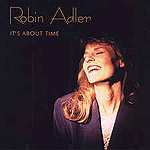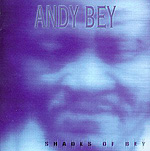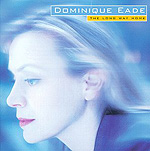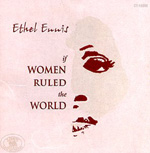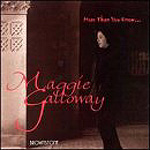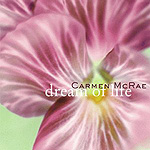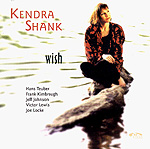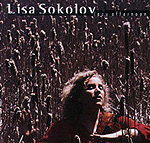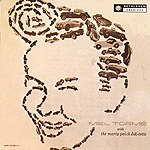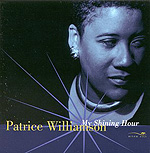
The jazz singers
|
These reviews first appeared in the April 24, 1999 edition of the American Reporter.
The last year has seen an incredible number of top-notch vocal releases. It's hard to think of a time when so many new singers and so many veterans were active in the studio – and especially of a time when the caliber of releases was so consistently high.
And they ain't all New Yorkers, either. Robin Adler, for instance, hails from the agricultural hamlet of Fallbrook, Calif., in the outskirts of San Diego where the musical taste runs more to country western than jazz.
But once you spin this disc, you'll wonder what on earth she's doing hidden away among the avocado groves. This is an artist who deserves a wider audience – more importantly, the audience deserves her, too.
There are plenty of pretty voices out there. Adler takes those great tones of hers and couples them to a style that is both distinct and imaginative. As with other singers with roots in San Diego, like Kevyn Lettau and Debra Liv Johnson, Adler shares the same Latin influences and open, airy sound. Reflecting Southern California, this San Diego school of singing is engaging, upbeat and absolutely enjoyable.
Adler's cover of Alan Brandt and Bob Haymes' "That's All" is a delightful gem; light, caressing, touches of scat. Then she turns around and turns Paul Simon's "Hearts and Bones" into a pop-jazz excursion.
But Adler can also handle the darker material as well; her reading of "I Loves You Porgy" is reflective and anxious. (And Peter Sprague's acoustic guitar is out of this world.) And there are equally memorable covers of songs by Sting, Johnny Mercer and Antonio Carlos Jobim. Adler and husband Dave Blackburn co-wrote several songs here, which stand up to the better-known covers quite well, and there's also a Peter Sprague tune.
It's a wonderful recording by a wondrously talented singer whose talent is likely to lead her away from the foothills of San Diego to brighter lights, bigger cities.
(For more information, visit www.robinadler.com.)
~ ~ ~
As with Jimmy Scott a few years back, Andy Bey is making the most of a second chance. Both men were respected vocalists earlier in life (Scott in the '50s, Bey in the early '60s) before disappearing from the national scene.
Bey's second album for Evidence shows he's still on top of his form, still laying down some of the most sophisticated, hip jazz on the scene.
Like Billy Eckstine, Bey sings with perfect control. There is a sense of mature restraint about him that is both endearing and admirable. Possessed of a rich, deep voice, Bey conveys an air of worldly wisdom and smooth charm.
On his latest release, Bey swings through songs by Ellington, Thelonious Monk and Billy Strayhorn, plus equally interesting but far less famous songs. No matter – Bey is the consummate artist, and each song quickly becomes his own.
The backing band is led by stellar pianist Geri Allen, and they provide an active, aggressive backdrop to Bey's singing, an accompaniment that pushes as much as it supports.
~ ~ ~
When she first came on the scene a few years back, Dominique Eade quickly carved out a niche as a sultry chanteuse, an American Edith Piaf.
But subsequent albums have shown Eade to be an artistically ambitious singer. Her latest, on RCA Victor, shows her moving beyond strict jazz forms into a much more open and free approach to the music.
The album opens with a cover of Elton John's "Come Down in Time" before she jumps into a striking reading of Frank Loesser's "I'm Hans Christian Anderson." Other covers include Hoagy Carmichael's "Baltimore Oriole," Harold Arlen's "Let's Take the Long Way Home" and Henry Mancini's "Two for the Road." There's even a cover of Ornette Coleman included – not territory for the timid.
With this set, Eade has moved herself into the orbit of the top female interpretive singers – place her alongside Carmen Lundy and Nnenna Freelon.
~ ~ ~
Ethel Ennis is another rediscovery. Like the above Andy Bey, Ennis found success early in life but then decided there was more to life – and walked away. Last year, she returned to the studio to make an album of songs written by women.
It's a pretty wide variety in styles – composers range from Billie Holiday to Joan Armatrading, Joan Osborne to Carole King. But Ennis straight-ahead approach to the music serves her well; she doesn't try to change the songs, but sings them as they are – and as she is. So it's Joan Osborne's "Spider Web" as a jazz song; Joni Mitchell as jazz.
All of which works fairly well. The songs she selected are interesting enough to stand up to a jazz presentation, and Ennis is accomplished enough to find the depth and nuance in them.
The backing band includes some pretty heavy players, too: Marc Copland on piano, John Ambercrombie on guitar, Billy Hart on drums.
The result of serious jazz atmosphere with pop-oriented songs is an album that's fun without becoming breezy, listenable yet also worthy of repeated listenings.
~ ~ ~
Maggie Galloway is keeper of the flame. The Boston-based singer's latest album (although it's over a year old now) is a celebration of the American songbook. Rodgers & Hammerstein, Ellington and Strayhorn, Hoagy Carmichael and Gene Krupa.
Her voice is just lovely, and her singing combines that natural beauty with a sweet, uncomplicated approach that creates a classic effect. The best analogy might be to imagine if Karen Carpenter had lived long enough to tackle some serious jazz material. It's an incredible coupling of talent and quality that keeps this disc in the CD player play after play.
Another highlight of this album is that the always-interesting Bob Nieske holds down the bass chair. And while the rest of the small combo isn't as well known, they're every bit as good and set a perfect table for Galloway.
~ ~ ~
Like her contemporary, Billie Holiday, the late Carmen McRae continued to improve as a singer even as her voice fell apart. (Of course, with Holiday it was heroin that ravaged her voice; McRae was victim only of her longevity.) A new release captures her from a 1989 set with the WDR Big Band from Europe, only five years before she passed at age 74.
When "Dream of Life" was recorded, McRae's voice was rough and tattered about the edges. But McRae – like Holiday and Sinatra before her and Anita O'Day since – took her vocal limitations and made them her strength.
She no longer even attempted to hit the notes she once could, no longer relied on purity of tone to convey emotion. Instead, she wrapped herself into the song, used the serrated edges of her voice to cut right into your heart.
As anyone who's ever heard any of the WDR Big Band's imports knows, this is one of the more underrated jazz ensembles around. Backing McRae, the band provides the perfect foundation – they swing, they bounce, they know when to get out of the way.
The song selection is vintage McRae: everything from Thelonious Monk to Leon Russell. More than almost any other singer of her generation, McRae could range beyond the jazz idiom to find songs that she could make her own.
~ ~ ~Kendra Shank has a "voice." Not just a pleasant set of vocal cords, although she has that, too. But a sound, a presence, a distinctive, personal sound that is immediately identifiable.
Actually, she doesn't have great range. And there are prettier voices out there. But when you listen to her get inside of "Black is the Color of My True Love's Hair," you know this is someone with musical vision, vision that transcends lesser issues such as tone or range.
And she's got some gumption, too. How many female singers would have the nerve to tackle Abbey Lincoln? Shank's version of "Should've Been" is as different from Lincoln's as could be; and nearly as good.
There are times here when it seems Shank is showing off a bit; putting technique before artistry, saying, "See what I can do."
But those are few, and when balanced against the whole of the album, minor complaints.
~ ~ ~
Lisa Sokolov is easily the most experimental singer in this group. According to a biography of her on the Web, she is as active as a musical theorist as a performer.
And that shows on her second outing. Whether tackling an overtly complex composition or turning a standard into experimental fare, Sokolov is disinclined to choose the road previously traveled.
Take "Simple Gifts," the old Shaker song. Aaron Copeland incorporated it into his "Fanfare for the Common Man," making it high art. Sokolov turns it inside out and makes it performance art. The same goes for "Sunnyside of the Street," "On a Clear Day" and "Over the Rainbow."
But if Sokolov has a knack for taking the overly familiar and making them into space aliens, it's always done with panache and the sense of a clearly defined goal. Her startling meanderings never come across as noise; annoying at times, yes, but never random, never unplanned.
Rather, it is simply that her vision is different from ours. Which is refreshing and rewarding more often than it is annoying.
Besides, Sokolov has a wondrous voice – rich, pure, supple. You could listen to her sing anything and enjoy it just for the aural pleasure.
~ ~ ~
Mel Torme has been silenced by a stroke these past few years, unable to perform due to his infirmities. While we wait for his return, a reissue of a 1957 album reminds anew of how great a voice we had among us for so very long.
When he set out to record "Lulu's Back in Town," his commercial success was finally allowing him to establish some control over his own career. For this set, he teamed up with pianist Marty Paich and band and decided to tackle serious jazz material rather than the kind of lightweight stuff his record companies had been throwing at him.
The result was magnificent, on an equal to Sinatra's classic albums of the same period (if in a completely different vein). From the opening notes of the bouncing "Lulu's Back in Town" to the Latin-tinged "The Carioca" to Ellington's "The Blues," every song offers challenges aplenty for an ambitious singer.
Torme conquers them all, and turns in some defining versions – not only on "Lulu" (which became his signature piece), but on the Gershwins' "Fascinating Rhythm" and George Shearing's "Lullaby of Birdland."
This album hasn't been available for awhile; having it out now in CD with the original liner notes is as close to a public service as a for-profit company can get.
~ ~ ~
Patrice Williamson may be the purest jazz singer of this group. Others have better voices, some are more experimental. Not one of them can come close to touching Williamson when it comes to improvising, or scatting, though.
She has a deep voice of rich timbre and a real swing to her singing. While she sounds nothing like Ella Fitzgerald, Williamson possesses the same feeling for jazz, a feeling that permeates every note she sings.
The songs she selected for this disc all lend themselves to her approach: "Wail" by Bud Powell, "Fascinating Rhythm" and "Love is Here to Stay" by George Gershwin, "Blue Skies" by Irving Berlin. Plus others by Johnny Mercer, Stevie Wonder and Carmen Lundy.
Williamson doesn't do a lot of out-there stuff – she's pretty straight-forward in her delivery. But she has no need for gimmicks – it's simply wonderful songs sung in the great jazz tradition by a gifted singer.
Who could ever need more than that?
